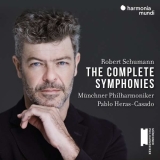Nun ist Schumann also beim Physiotherapeuten Pablo Heras-Casado gelandet, der seiner Musik eine Bewegungstherapie auferlegt, wie man sie noch nicht oft gehört hat. Dazu muss ich gleich anfügen, dass wir es nicht mit einem außergewöhnlich schnellen oder nervösen Schumann zu tun haben, ganz und gar nicht, aber eben mit einem, in dem sich alles sehr viel bewegt, manchmal mit jugendlicher Frische und spritzig-leichter Verve, oft mit tänzerisch-kantablem Schwung, in den langsamen Sätzen auch mit viel Wärme und Innigkeit.
Die romantischen Gefühle kommen also durchaus zum Ausdruck in diesen letztlich sehr rhetorischen, manchmal bedeutungsvoll gestischen, immer perfekt geatmeten, mit vernünftigem Rubato und feinen dynamischen Nuancen angereicherten Interpretationen.
Charakteristisch in der Ersten Symphonie ist wohl das Finale, das bei allem ‘animato’ auch das geforderte ‘grazioso’ enthält. Aus der Zweiten, in der viele Stimmungswechsel zur Geltung kommen, wird mir ein ganz besonders schönes, ausdrucksvolles Adagio in Erinnerung bleiben.
In der Dritten fallen die viele Farben auf, auch im 4. Satz, Feierlich, in dem das Feierliche nicht von Pathos herrührt, sondern von Kantabilität und Seele.
Für die Vierte Symphonie benutzt Heras-Casado die revidierte Fassung von 1851. Er sorgt sich ständig um den Fluss der Musik, um Kraft und Spannung. Dabei ornamentiert er recht üppig und lässt das Orchester singen, wo immer es notwendig ist. Der Höhepunkt der Aufnahme ist der Übergang vom dritten zum letzten Satz, der besonders schön gestaltet wird.
Und so haben wir es hier mit einem kohärenten, stimmigen Schumann-Zyklus zu tun, der eigentlich nichts aufregend Neues zu sagen hat, aber das, was er sagt, überzeugend ans Ohr bringt.
So now Schumann has landed with the physiotherapist Pablo Heras-Casado, who imposes a kinesitherapy on his music the likes of which have not often been heard. I must add that we are not dealing with an extraordinarily fast or nervous Schumann, not at all, but with one in which everything is constantly in motion, sometimes with youthful freshness and lively, light verve, often with dance-like, cantabile elan, in the slow movements also with a lot of warmth and intimacy.
Romantic feelings are thus certainly expressed in these ultimately very rhetorical, sometimes meaningfully gestural, always perfectly breathed interpretations, enriched with judicious rubato and fine dynamic nuances.
Characteristic in the First Symphony is probably the finale which, for all its ‘animato’, also contains the required ‘grazioso’. From the Second, in which many mood changes come to the fore, a particularly beautiful, expressive Adagio will remain in my memory.
In the Third, the many colors stand out, including in the 4th movement, Feierlich, in which the solemnity comes not from pathos, but from cantabile and soul.
For the Fourth Symphony, Heras-Casado uses the revised version of 1851, constantly worrying about the flow of the music, about power and tension. In doing so, he ornaments quite lushly and lets the orchestra sing wherever necessary. The highlight of the recording is the transition from the third to the last movement, which is especially beautifully shaped.
And so what we have here is a coherent Schumann cycle that doesn’t really have anything excitingly new to say, but brings what it does say convincingly to the listener’s ears.






















